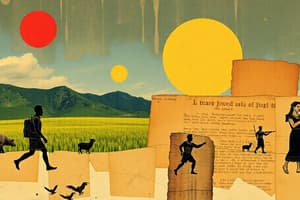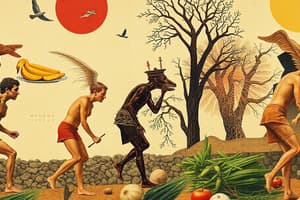Podcast
Questions and Answers
What characterizes the Agricultural Revolution?
What characterizes the Agricultural Revolution?
- Rise of trade without agriculture
- Transition to nomadic lifestyles
- Increased reliance on wild food sources
- Shift from hunter-gatherer to agricultural societies (correct)
Which of the following best describes the role of domestication during the Agricultural Revolution?
Which of the following best describes the role of domestication during the Agricultural Revolution?
- Cultivation of crops and breeding of animals (correct)
- Humans continued hunting and gathering exclusively
- Development of new species of wild plants
- Complete elimination of animal husbandry
What contributed to population growth during the Agricultural Revolution?
What contributed to population growth during the Agricultural Revolution?
- Introduction of sedentary lifestyles (correct)
- Increased hunting activities
- Population decline due to disease
- Reversion to nomadic practices
What impact did the Agricultural Revolution have on social structures?
What impact did the Agricultural Revolution have on social structures?
What was one of the key consequences of agricultural practices during this period?
What was one of the key consequences of agricultural practices during this period?
How did the Agricultural Revolution affect health compared to hunter-gatherer societies?
How did the Agricultural Revolution affect health compared to hunter-gatherer societies?
What is a significant feature of the geographical variations of the Agricultural Revolution?
What is a significant feature of the geographical variations of the Agricultural Revolution?
Which of the following describes the lifestyle change resulting from the Agricultural Revolution?
Which of the following describes the lifestyle change resulting from the Agricultural Revolution?
Flashcards
Agricultural Revolution
Agricultural Revolution
The shift from nomadic hunter-gatherer lifestyles to settled agricultural communities, marked by domestication of plants and animals, leading to food surplus, population growth, and the development of villages and civilizations.
Domestication
Domestication
Process of selecting and breeding plants and animals for desired traits, leading to a controlled and reliable food source.
Sedentary Lifestyle
Sedentary Lifestyle
Having a permanent place to live, allowing for the cultivation of crops and the development of settlements.
Food Surplus
Food Surplus
Signup and view all the flashcards
Population Growth
Population Growth
Signup and view all the flashcards
New Technologies
New Technologies
Signup and view all the flashcards
Specialization of Labor
Specialization of Labor
Signup and view all the flashcards
Environmental Changes
Environmental Changes
Signup and view all the flashcards
Study Notes
Definition of Agricultural Revolution
- The Agricultural Revolution, also known as the Neolithic Revolution, is a significant transition in human history.
- It shifted human societies from nomadic hunter-gatherer lifestyles to settled agricultural communities.
- Domesticating plants and animals produced a food surplus.
- This surplus led to population growth, village development, and ultimately, the rise of civilizations.
Key Features of the Agricultural Revolution
- Domestication of plants and animals: Humans cultivated crops and selectively bred animals for desirable traits.
- Sedentary lifestyle: Food production in a fixed location enabled permanent settlements.
- Food surplus: Agricultural practices yielded more food than needed, leading to storage and trade.
- Population growth: Increased food supplies supported larger populations, creating denser settlements.
- Development of new technologies: Tools and techniques related to agriculture and food processing emerged.
- Specialization of labor: Food surpluses allowed people to pursue roles beyond food production, like craftspeople and administrators.
Geographic Variations
- The Agricultural Revolution wasn't simultaneous globally.
- Different regions experienced the transition at varying times and in diverse ways.
- Independent centers of origin arose, often utilizing local plant and animal species.
- These independent agricultural developments influenced human societal development.
Consequences of the Agricultural Revolution
- Environmental changes: Agriculture caused deforestation, soil erosion, and other environmental shifts.
- Social stratification: Surplus accumulation led to social hierarchies and inequalities.
- Population densities: Settlements grew larger and denser.
- Impact on health: Agricultural diets may have negatively impacted health compared to hunter-gatherer diets, while offering improved nutrition possibilities.
- Evolution of tools: Tools and techniques connected to agriculture advanced.
- Economic changes: Trade and exchange systems emerged for managing resources and surpluses.
- Development of permanent villages: Farming enabled the establishment of settlements.
Impact on Human Society
- The Agricultural Revolution profoundly impacted human society.
- It laid the foundations for more complex social structures.
- It fostered the growth of cities and civilizations.
- It resulted in a fundamental shift in the relationship between humans and the environment.
Studying That Suits You
Use AI to generate personalized quizzes and flashcards to suit your learning preferences.




